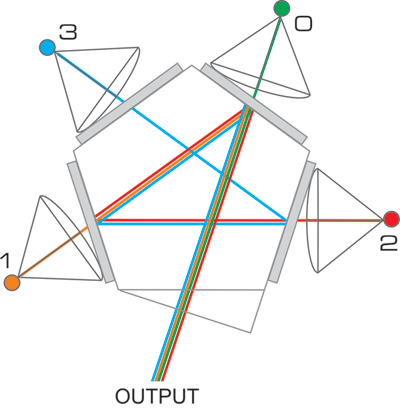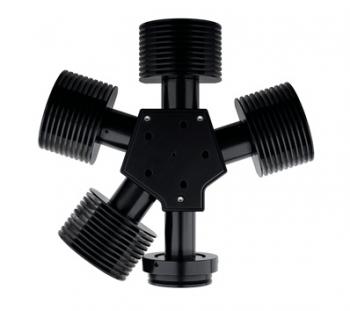Optical Beam Combiner Sutter Lambda OBC
The Lambda OBC optical beam combiner is an original patented development by Sutter, which is a pentagon with four LED sources sending beams through a system of reflectors.
- Overview
- Specifications
- Links
A brand-new, patented idea called the Lambda OBC (optical beam combiner) combines various light sources with various spectra into a single common output beam. Before passing through a bandpass filter and onto the optical path, each individual light source is collimated. Each light source's filters serve as mirrors that reflect the collimated beams from the preceding sources of light. The optical routes for each point, including the reflections that take place, are shown in the picture below:

Optical paths for the light sources at each of the positions 0 through 3. The light source's position is determined by the total number of reflections.
Originally, a dichroic ladder was used to combine more than two light sources. If the wavelengths of the various light sources do not overlap, dichroic mirrors, which change from transmission to reflection at a certain point in the spectrum, enable the merging of different light sources. This method's drawback is that light sources are difficult to switch.
In order to prevent the light from being obstructed by the next dichroic in line, dichroic ladders also necessitate particular attention to the order in which the light sources are placed into the optical path. To choose the desired range of wavelengths for every light source, additional bandpass filters must often be placed before the dichroic. The ladder's overall light output diminishes with each filter and dichroic employed in it.
FEATURES
- Very high speed LED light source with up to 4 channels (< 25µsec)
- For many popular microscopes, there are direct mount or LLG connection options
- Ability to combine any combination of LEDs or any light sources given by liquid light guides
- Simple to modify
- LEDs are powered by Sutter's reliable FLED controllers
The Lambda OBC's pentagonal shape was chosen to maintain a compact beam combiner and an effective, short optical path. The STR from Semrock and other thin-film bandpass filters reflect more than 90% of out-of-band light. It is possible to employ the filters for both light attenuation and reflection from the other sources if the band passes of the individual light sources do not overlap. We were able to combine four light sources in a small design with fewer losses than was previously possible by organizing the filters and sources into a pentagon. Also, since no other input reflects from the last place in the optical train, there is no need for a filter there. If you are aware of the potential losses if there are filters in use that overlap this light source, you can utilize this input with any type of light source. The output for the combined sources is the fifth side of the pentagon. The filters are mounted on little sliders inside the pentagon's core and are easily exchangeable. Around the pentagon, light sources and related filters can be organized in any configuration.
Based on the total number of reflections, the location numbers of the light sources are identified in the diagram below.

Notes:
- Without being reflected, light from location #0 travels straight to the device output. The source with the highest desired output may choose to be in this position.
- If a broad-band source were preferred, the filter for the fourth light source might be removed because it is not employed as a reflective surface.
- To provide the highest light output in setups with less than four light sources, sources should be filled from the lowest to the highest number of reflections.
- Each input's optical path is angled at an angle of 18 degrees with respect to the port's filter. The band pass will somewhat shift in favor of shorter wavelengths as a result. While a coating tailored for this purpose would be preferable, stock -STR filters can be utilized if the band pass shift is taken into account while choosing the filters. It is possible to combine narrow-band sources like LEDs and lasers with broad-band sources like arc lamps or white light LEDs because of this. When it comes to LEDs, wavelengths can be shuttered at the rate of the particular source. Products from Sutter Instrument like the HPX and FLED can switch in 10 to 25 microseconds, respectively. The Lambda OBC is made to be as flexible and expandable as possible. If your lighting requirements alter over time, a quick configuration modification and potentially some extra filters can result in a completely different output.
You can also visit site of the manufacturer.


